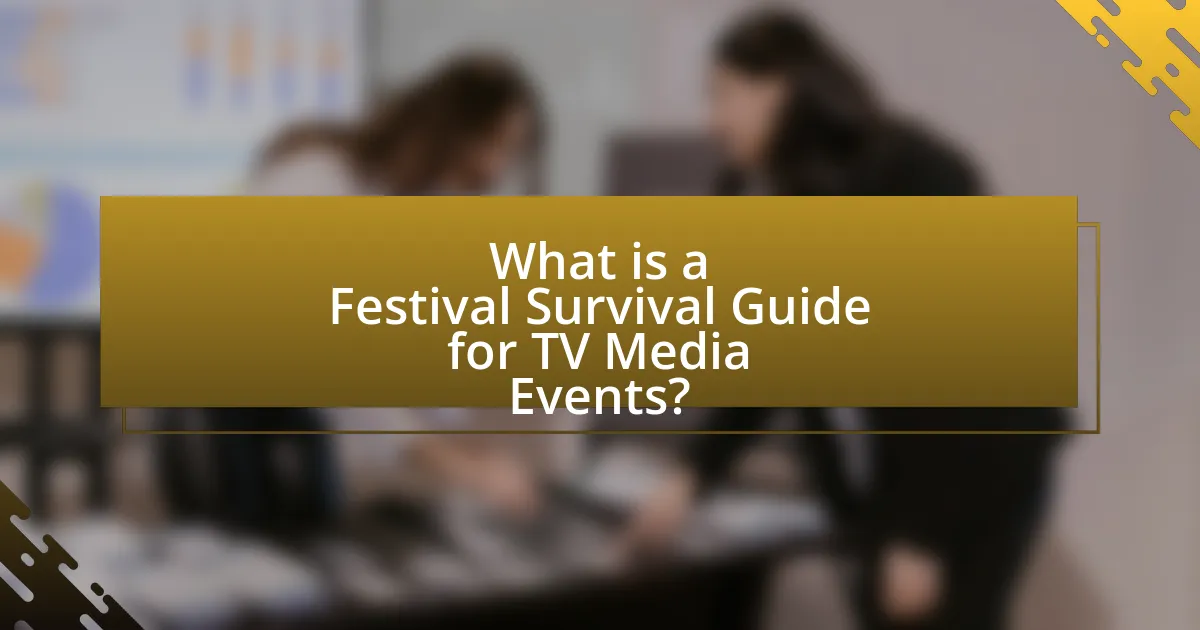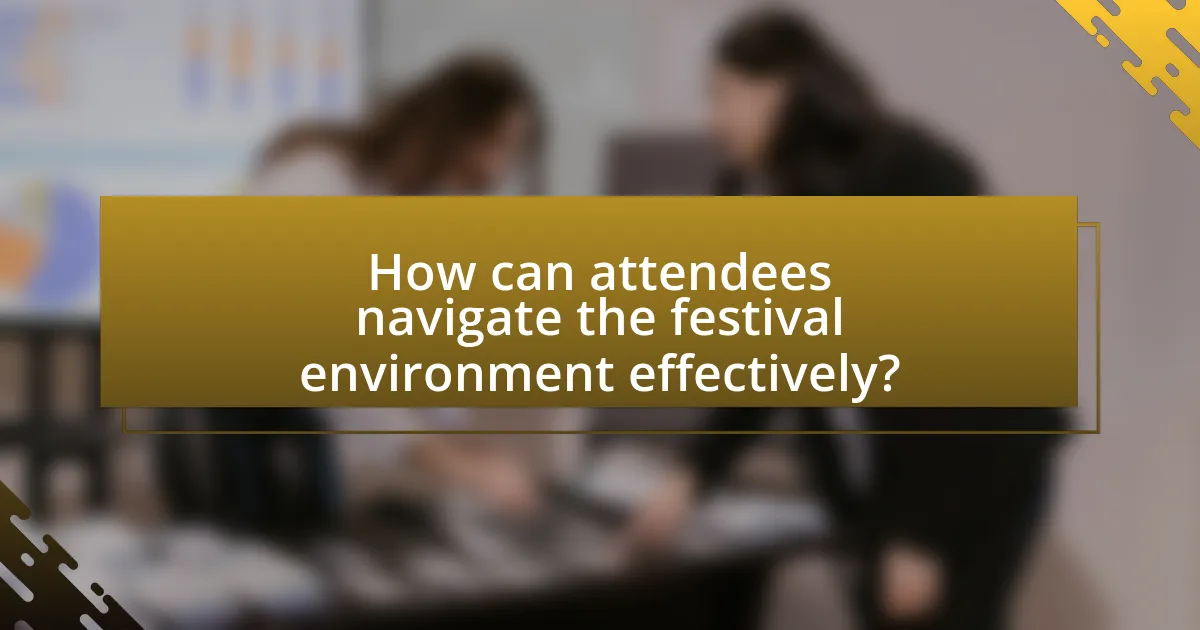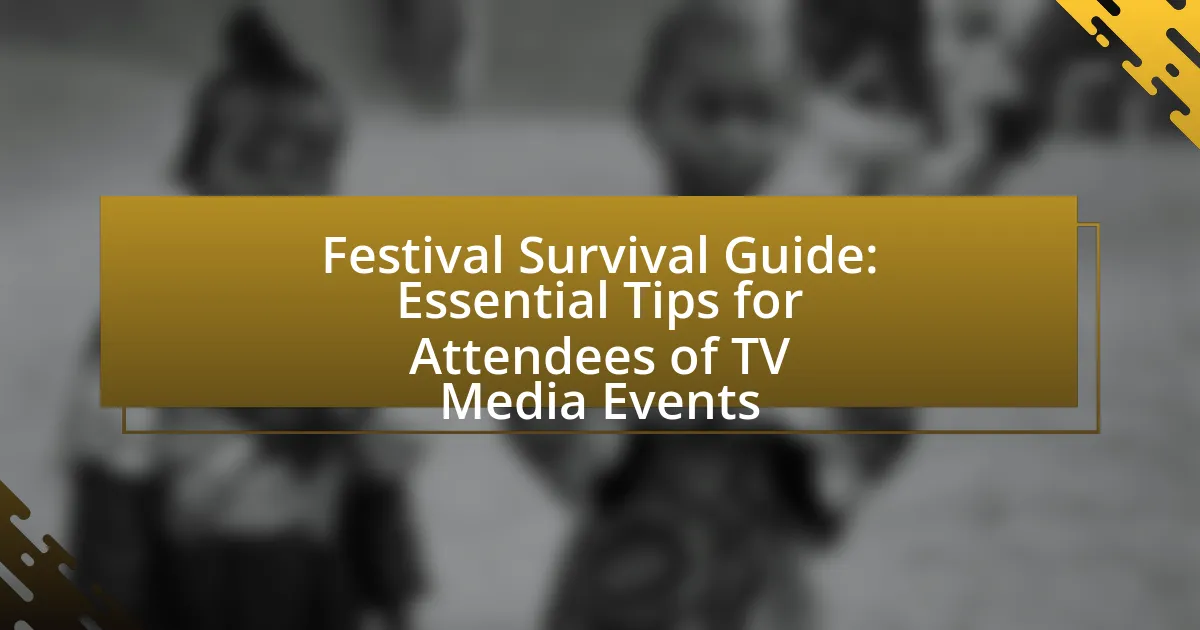The article provides a comprehensive Festival Survival Guide specifically tailored for attendees of TV media events. It outlines essential preparation tips, including scheduling, networking strategies, and navigating event layouts, while addressing common challenges such as overcrowding and logistical issues. Key components of the guide include packing lists, safety tips, hydration strategies, and advice for managing time effectively. Additionally, the article emphasizes the importance of maintaining personal safety and health during the event, offering practical troubleshooting tips for unexpected situations. Overall, this guide serves as a valuable resource for enhancing the festival experience and maximizing professional opportunities.

What is a Festival Survival Guide for TV Media Events?
A Festival Survival Guide for TV Media Events is a comprehensive resource designed to help attendees navigate the complexities of such events effectively. This guide typically includes essential tips on preparation, such as scheduling, networking strategies, and understanding event layouts. For instance, attendees are advised to plan their schedules in advance to prioritize key panels and networking opportunities, which can enhance their experience and professional connections. Additionally, the guide often emphasizes the importance of staying hydrated and taking breaks to maintain energy levels throughout the event, as these factors significantly impact overall engagement and enjoyment.
Why is a Survival Guide important for attendees?
A Survival Guide is important for attendees because it provides essential information and strategies to navigate the complexities of TV media events effectively. This guide typically includes details on event schedules, venue layouts, safety protocols, and tips for maximizing networking opportunities. For instance, attendees can benefit from knowing the locations of key sessions and amenities, which can enhance their overall experience and ensure they do not miss critical opportunities. Additionally, having a Survival Guide can reduce stress and uncertainty, allowing attendees to focus on engaging with content and networking, ultimately leading to a more productive and enjoyable event.
What challenges do attendees face at TV media events?
Attendees at TV media events face several challenges, including overcrowding, limited access to key speakers, and logistical issues such as transportation and scheduling conflicts. Overcrowding can lead to difficulties in networking and accessing sessions, as high attendance often results in long lines and packed venues. Limited access to key speakers can hinder attendees’ ability to engage with industry leaders, as many events have restricted time slots for Q&A sessions. Logistical issues, such as transportation delays and overlapping schedules, can further complicate the experience, making it challenging for attendees to maximize their time and opportunities at the event.
How can a Survival Guide enhance the festival experience?
A Survival Guide can enhance the festival experience by providing attendees with essential information and strategies for navigating the event effectively. This guide typically includes details on location maps, schedules, safety tips, and packing lists, which help attendees plan their visit and avoid common pitfalls. For instance, a study by the Event Marketing Institute found that 78% of festival-goers reported feeling more prepared and less stressed when they had access to a comprehensive guide. By equipping attendees with knowledge about amenities, emergency procedures, and local resources, a Survival Guide significantly improves their overall enjoyment and safety at the festival.
What key components are included in a Festival Survival Guide?
A Festival Survival Guide typically includes essential components such as packing lists, safety tips, hydration strategies, food options, and transportation information. Packing lists ensure attendees bring necessary items like sunscreen, portable chargers, and comfortable clothing. Safety tips cover emergency contacts, venue rules, and personal safety measures. Hydration strategies emphasize the importance of drinking water and locating refill stations. Food options provide insights into available vendors and dietary accommodations. Transportation information outlines parking, public transit, and ride-sharing services to facilitate easy access to the festival. These components collectively enhance the festival experience by ensuring preparedness and safety.
What essential items should attendees pack?
Attendees should pack essential items such as comfortable clothing, sunscreen, water bottles, portable chargers, and snacks. Comfortable clothing is crucial for long hours of standing or walking, while sunscreen protects against sunburn during outdoor events. Water bottles are necessary for hydration, especially in crowded environments. Portable chargers ensure that devices remain powered for communication and navigation, and snacks provide energy throughout the day. These items enhance the overall experience and ensure attendees are prepared for various situations at TV media events.
How can attendees prepare for different weather conditions?
Attendees can prepare for different weather conditions by checking the forecast in advance and packing accordingly. For instance, if rain is expected, attendees should bring waterproof clothing, such as raincoats and waterproof shoes, as well as umbrellas. In contrast, for sunny weather, packing sunscreen, hats, and sunglasses is essential to protect against UV rays. Additionally, layering clothing is advisable for fluctuating temperatures, allowing attendees to adjust their attire as needed throughout the day. Historical data shows that weather can significantly impact outdoor events, making preparation crucial for comfort and enjoyment.

How can attendees navigate the festival environment effectively?
Attendees can navigate the festival environment effectively by utilizing a combination of planning, awareness, and resourcefulness. First, attendees should familiarize themselves with the festival layout, including stages, rest areas, and vendor locations, often provided in festival maps or apps. This knowledge allows for efficient movement between events and minimizes the risk of getting lost.
Additionally, attendees should stay updated on schedules and any changes through official festival communication channels, such as social media or event apps, ensuring they do not miss key performances or activities.
Moreover, using designated pathways and following signage can enhance navigation and safety, as these routes are designed to manage crowd flow. Attendees should also consider arriving early to avoid congestion and secure optimal viewing spots.
Finally, maintaining situational awareness by observing surroundings and being mindful of crowd dynamics can help attendees make informed decisions about when and where to move. These strategies collectively contribute to a smoother and more enjoyable festival experience.
What strategies can help attendees manage their time at the event?
Attendees can manage their time at the event by creating a detailed schedule that prioritizes key sessions and activities. This strategy allows attendees to allocate specific time slots for workshops, networking opportunities, and panel discussions, ensuring they do not miss important content. Additionally, using event apps or printed agendas can help attendees track their progress and make real-time adjustments based on their interests and the event’s dynamics. Research indicates that effective time management techniques, such as setting clear goals and minimizing distractions, can enhance overall event experience and engagement.
How can attendees prioritize sessions and activities?
Attendees can prioritize sessions and activities by assessing their personal interests, professional goals, and the relevance of each session to their objectives. By reviewing the event schedule in advance, attendees can identify key sessions that align with their interests and career aspirations, ensuring they maximize their time at the event. Research indicates that attendees who plan their schedules based on specific goals are more likely to report higher satisfaction and engagement levels during events.
What tools can assist in scheduling and navigation?
Tools that can assist in scheduling and navigation include mobile applications such as Google Calendar for organizing events and schedules, and Google Maps for real-time navigation and location tracking. Google Calendar allows users to set reminders and share schedules, enhancing coordination among attendees. Google Maps provides detailed directions, traffic updates, and estimated travel times, which are crucial for navigating large festival venues efficiently. These tools are widely used and supported by millions of users, ensuring reliability and ease of access during events.
How can attendees maximize networking opportunities?
Attendees can maximize networking opportunities by actively engaging with other participants through strategic interactions. This includes initiating conversations, asking open-ended questions, and following up with contacts after the event. Research indicates that networking can lead to significant career advancements; for instance, a study by the Harvard Business Review found that 70% of jobs are obtained through networking. Additionally, utilizing social media platforms like LinkedIn to connect with fellow attendees can enhance visibility and foster ongoing relationships.
What are the best practices for meeting industry professionals?
The best practices for meeting industry professionals include preparing an elevator pitch, actively networking, and following up after initial meetings. Preparing an elevator pitch allows individuals to succinctly communicate their background and interests, making a strong first impression. Actively networking involves attending relevant events, engaging in conversations, and utilizing social media platforms like LinkedIn to connect with professionals in the industry. Following up after initial meetings is crucial; sending a personalized message or email reinforces the connection and opens the door for future interactions. These practices are supported by research indicating that effective networking can lead to job opportunities and collaborations, as highlighted in studies by the Networking Research Group.
How can attendees follow up after the event?
Attendees can follow up after the event by reaching out to speakers and fellow participants through email or social media platforms. This approach fosters networking opportunities and allows attendees to express gratitude, ask questions, or continue discussions initiated during the event. Research indicates that effective follow-up communication can enhance professional relationships, with 70% of professionals valuing post-event engagement as a key factor in networking success.

What are the best practices for staying safe and healthy at festivals?
To stay safe and healthy at festivals, attendees should prioritize hydration, sun protection, and awareness of their surroundings. Hydration is crucial; studies show that dehydration can lead to fatigue and heat-related illnesses, so drinking water regularly is essential. Sun protection, including wearing sunscreen and protective clothing, helps prevent sunburn and heat exhaustion, which are common at outdoor events. Additionally, being aware of surroundings and keeping personal belongings secure reduces the risk of theft and enhances personal safety. Following these practices can significantly improve the festival experience while minimizing health risks.
How can attendees ensure their personal safety during the event?
Attendees can ensure their personal safety during the event by remaining aware of their surroundings and following established safety protocols. This includes staying in well-lit areas, avoiding isolated spots, and keeping personal belongings secure. According to the National Safety Council, situational awareness significantly reduces the risk of accidents and incidents, as individuals who are alert can respond more effectively to potential threats. Additionally, attendees should familiarize themselves with emergency exits and the location of security personnel, which enhances their ability to react swiftly in case of an emergency.
What precautions should be taken against potential hazards?
Attendees of TV media events should take precautions such as staying aware of their surroundings, following safety protocols, and having an emergency plan. Awareness of the environment helps individuals identify potential hazards like overcrowding or unsafe structures. Following established safety protocols, such as those provided by event organizers, ensures compliance with safety measures designed to mitigate risks. Additionally, having an emergency plan, including knowing the location of exits and first aid stations, prepares attendees for unexpected situations, enhancing overall safety during the event.
How can attendees stay aware of their surroundings?
Attendees can stay aware of their surroundings by actively engaging in their environment and utilizing situational awareness techniques. This involves regularly scanning the area for potential hazards, being mindful of the people around them, and listening for announcements or changes in the event. Research indicates that maintaining situational awareness can significantly reduce the risk of accidents and enhance personal safety in crowded environments, as highlighted in studies on crowd dynamics and safety protocols.
What health tips should attendees consider while at the festival?
Attendees should stay hydrated by drinking plenty of water throughout the festival. Dehydration can lead to fatigue, dizziness, and heat-related illnesses, especially in crowded outdoor environments. According to the Centers for Disease Control and Prevention (CDC), individuals should consume at least 8 ounces of water every 20 minutes during physical activity in hot weather. Additionally, attendees should wear sunscreen with a high SPF to protect against sunburn, as UV exposure can cause skin damage and increase the risk of skin cancer. The American Academy of Dermatology recommends applying sunscreen 15 minutes before sun exposure and reapplying every two hours. Lastly, attendees should take breaks in shaded or cool areas to prevent overheating and fatigue, as prolonged exposure to heat can lead to heat exhaustion or heat stroke.
How can attendees maintain hydration and nutrition?
Attendees can maintain hydration and nutrition by regularly consuming water and nutrient-rich foods throughout the event. Staying hydrated requires drinking water consistently, aiming for at least 8 ounces every hour, especially in warm environments where dehydration is more likely. For nutrition, attendees should prioritize snacks that are high in protein and complex carbohydrates, such as nuts, granola bars, and fruits, which provide sustained energy. Research indicates that proper hydration improves cognitive function and physical performance, making it essential for enjoying and participating in events effectively.
What should attendees do in case of a medical emergency?
In case of a medical emergency, attendees should immediately call for medical assistance or locate the nearest first aid station. This action ensures that trained medical personnel can respond quickly to the situation. Attendees should also provide clear information about the emergency, including the location and nature of the medical issue, to facilitate a swift response. Prompt reporting of emergencies is critical, as statistics show that timely medical intervention can significantly improve outcomes in emergency situations.
What are the common troubleshooting tips for festival attendees?
Common troubleshooting tips for festival attendees include staying hydrated, keeping a portable charger for devices, and having a clear plan for meeting points in case of separation. Staying hydrated is crucial, as festivals often involve long hours outdoors, and dehydration can lead to fatigue or health issues. A portable charger ensures that attendees can maintain communication and access important information throughout the event. Establishing meeting points helps attendees navigate large crowds and reduces anxiety if they become separated from their group. These strategies are essential for enhancing the overall festival experience and ensuring safety.
How can attendees handle unexpected changes in the schedule?
Attendees can handle unexpected changes in the schedule by remaining flexible and adapting their plans accordingly. Flexibility allows attendees to quickly adjust to new time slots or activities, ensuring they still make the most of the event. Additionally, staying informed through official event communication channels, such as social media updates or event apps, helps attendees receive real-time information about schedule changes. This proactive approach minimizes confusion and enhances the overall experience at TV media events.
What should attendees do if they lose their belongings?
Attendees who lose their belongings should immediately report the loss to the event’s lost and found department. This department is typically established at large events to assist individuals in recovering lost items. Additionally, attendees should provide a detailed description of the lost belongings, including any identifiable features, to facilitate the recovery process. Many events also have a dedicated online platform or social media page where lost items can be reported and tracked, enhancing the chances of retrieval.
What are the top tips for a successful festival experience?
To ensure a successful festival experience, attendees should prioritize planning, hydration, and safety. Planning involves researching the festival schedule, mapping out stages, and identifying key performances to avoid missing favorite acts. Hydration is crucial, as studies show that staying hydrated can enhance energy levels and overall enjoyment, especially in crowded and hot environments. Safety measures include being aware of surroundings, keeping personal belongings secure, and having a designated meeting point in case of separation from friends. These strategies collectively contribute to a more enjoyable and memorable festival experience.
How can attendees create a personalized festival plan?
Attendees can create a personalized festival plan by first reviewing the festival schedule and identifying key events, performances, or panels that align with their interests. This involves prioritizing must-see acts and allocating time for each, while also considering factors such as location, timing, and potential overlaps. Additionally, attendees should utilize festival apps or websites that provide real-time updates and personalized recommendations based on their preferences. Research shows that attendees who plan their schedules in advance are more likely to have a fulfilling experience, as they can manage their time effectively and avoid missing out on important activities.
What mindset should attendees adopt for a positive experience?
Attendees should adopt an open and adaptable mindset for a positive experience. This mindset allows individuals to embrace new opportunities, connect with diverse people, and navigate unexpected situations effectively. Research indicates that a positive mindset enhances social interactions and overall satisfaction at events, as demonstrated in studies showing that participants with a flexible attitude report higher enjoyment levels and better networking outcomes.

Leave a Reply